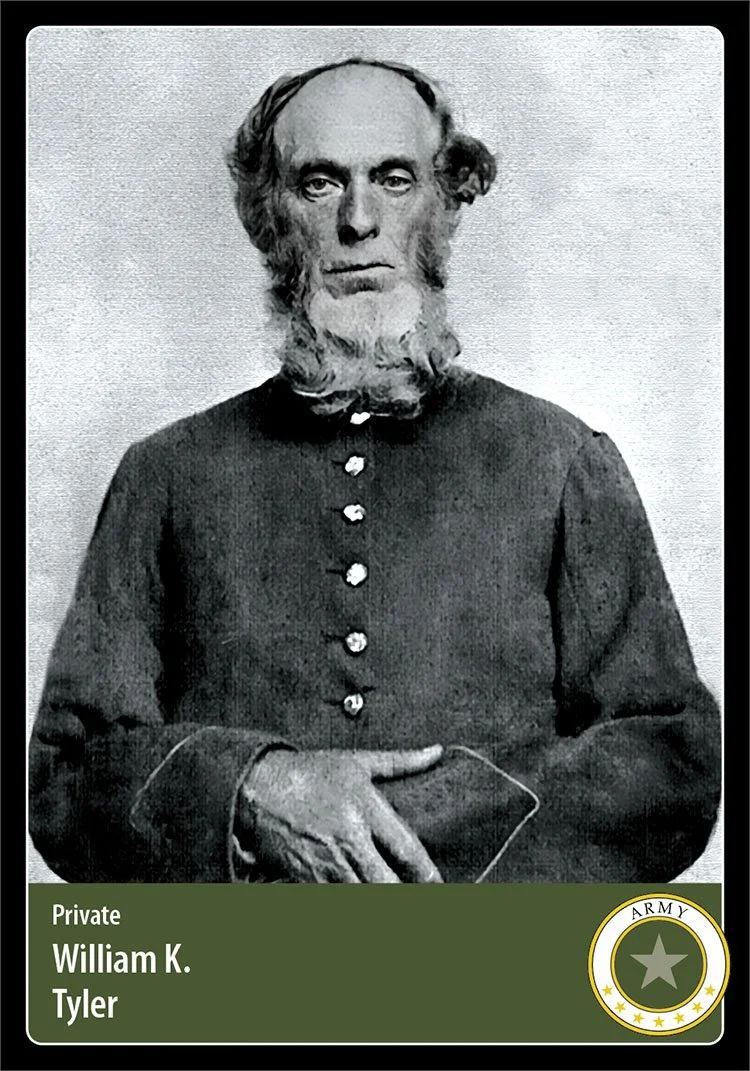Hero Card 269, Card Pack 23 [pending]
Photo (digitally restored) provided by the family.
Hometown: Fairport, IA
Branch: U.S. Army
Unit: Company B, 37th Iowa Infantry Division
Date of Sacrifice: September 10, 1863 - in Alton, Illinois
Age: 56
Conflict: Civil War, 1861-1865
He was born a southerner, opposed to slavery, and was too old for combat. Yet he would serve his country as a soldier in the U.S Army’s “Greybeard Regiment.”
William King Tyler was born on August 5, 1807, in Randolph County, North Carolina, to parents Charles and Mary (Gooley) Tyler. At the time, the United States had just passed its 31st birthday and there were 17 states in the Union.
William, along with his brothers John, Charles, Henry, and sisters Ruth, Mary, and Elisabeth, would spend their childhoods in the rolling hills, river valleys, and small farms of Randolph County.
When he was older, William took a teaching position in the town Citronelle, Alabama. There he met Elizabeth May Griffin, and the two would marry on May 26, 1841, in Painesville, Alabama. William was 33, and his young bride was a month short of her 16th birthday.
According to Tyler family records, the two would welcome ten children: Elizabeth, William C., Archibald, Missouri Ann, John, an unnamed infant who passed away, Charles, Edward, Henry, and Elizabeth May.
Family moves
To support the family, William went into the boot and shoe business, later tanning animal hides for more income. In 1855, the family began a series of moves to find more business—first to Muscatine County in eastern Iowa, then north to Dubuque, Iowa. They remained there for a short time, moved back south, and then moved again in 1856 to Cairo, Illinois.
In the fall of 1856, the family finally settled down in Fairport, Iowa, a small community along the Mississippi River, back in Muscatine County.
By 1860, there were 34 states in the Union. With 11 southern states seceding to form The Confederate States of America, largely over the issue of slavery, America was about to enter its bloodiest conflict.
Too old to serve
The two oldest Tyler boys would serve in the Union Army: William C. and Archibald. Their father, William K., despite being born and raised in the south, opposed the institution of slavery. But at 54 years of age, he was too old to enlist as a combat soldier in the Union Army.
Whether to oppose slavery, seek adventure, a need for steady income, or simply out of a sense of duty, many older men like William sought an opportunity to serve their country.
Two years into the war, hundreds of thousands of soldiers had been lost. George W. Kincaid, a farmer and civic leader from Muscatine County, Iowa, proposed that Governor Samuel J. Kirkwood raise a regiment of soldiers over the age of 45. What came to be known as the “Greybeard Regiment” would serve in non-combat roles such as guard and garrison duty.
The 37th Iowa Infantry Greybeard Regiment was made up of more than 1,000 men who were considered too old for military service—including William K. Tyler. Many of the men were in their 40s and 50s, some in their 60s and 70s. The average age of a Greybeard soldier was 57.
Guard duty
To join the regiment, the older men had to be physically able to perform the duties of a soldier. PVT Tyler was assigned to guard duty at a military prison in Alton, Illinois. During the Civil War, more than 11,000 prisoners would be held at Alton Prison.
Captured Confederate soldiers made up most of the prison population. Some citizens were held there as well, for treasonous actions or aiding escaped Confederates. Others, classified as “bushwhackers” or “guerrillas,” were imprisoned for actions such as bridge burning and railroad vandalism.
The American Battlefield Trust describes Alton Prison:
Conditions in the prison were harsh and the mortality rate was above average for a Union prison. Hot, humid summers and cold Midwestern winters took a heavy toll on prisoners already weakened by poor nourishment and inadequate clothing.
The prison was overcrowded much of the time and sanitary facilities were inadequate. Pneumonia and dysentery were common killers but contagious diseases such as smallpox and rubella were the most feared.
When smallpox infection became alarmingly high in the winter of 1862 and spring of 1863, a quarantine hospital was located on an island across the Mississippi River from the prison. Up to 300 prisoners and soldiers died and are buried on the island, now under water. A cemetery in North Alton that belonged to the State of Illinois was used for most that died. A monument there lists 1,534 names of Confederate soldiers that are known to have died. An additional number of civilians and Union soldiers were victims of disease and illness.
At age 56, PVT William K. Tyler was among those Union soldiers who lost their life to disease. In a letter home to Elizabeth, dated May 20, 1863, William complained of “a slow fever and great soreness in my limbs.” He’d succumb to illness on September 10 of that year. He was laid to rest in the Alton National Cemetery.
Death from illness was not unique to the Greybeards or to prison guards. According to Dr. Stanley B. Burns, in an article published by PBS, “Of the 620,000 recorded military deaths in the Civil War about two-thirds died from disease. However, recent studies show the number of deaths was probably closer to 750,000.”
Two of PVT William K. Tyler’s sons served in the America’s costliest conflict, on the side of the Union. William C. served the entire length of the war. Archibald was held as a prisoner by the Confederates, at Andersonville, Georgia. Both Tyler sons would survive the war.
Sources
Photo (digitally restored) and story details submitted by Debbie Powell-Bowen, PVT Tyler’s great-great-great granddaughter.
Portrait and Biographical Album of Muscatine County, Iowa: William K. Tyler (p. 389-390)
Military.com: The 'Graybeards' Were an Infantry Unit Just for Men Too Old for Military Service
IAGenWeb: Historical Sketch - Thirty-Seventh Iowa Volunteer Infantry
Iowa Legislative Services Agency: Mustering of the Graybeards: the 37th Infantry Regiment
American Battlefield Trust: Alton Military Prison Site
Burial Site: Find a Grave





